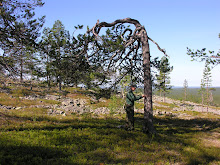My current vacancy at the UEF is "university researcher", but "lecturer" would be more correct as far as early 2012 is concerned. At the moment, I'm running course "advanced remote sensing", which has a strong focus on laser scanning but also other topics such as satellite images, radars and photogrammetry are covered. Visiting experts give most of the lectures, and my job mostly consists of supervising the students in computer labs.
Last week dealt with a topic that was especially important to me: physically based optical remote sensing. In previous years, the physical approach was covered in two lectures, but I wanted to emphasize this part more - after all, the University of Helsinki has an entire course on it (thanks to LAIDetectives!). So first I gave an introductory lecture where the basic concepts from irradiance to LAI were discussed. In the following computer lab, the students analyzed a set of hemispherical canopy images and had to consider different uncertainties of the process.
The highlight of the week was certainly the two lectures given by Miina. The topics included different reflectance model types, global monitoring with MODIS, and finally an introduction to PARAS reflectance model. We restricted the amount of equations on purpose - when the audience consists of forestry students, either the math has to be simple, or plenty of time must be reserved for explaining it. Miina's part ended with a detailed derivation of the PARAS model equation on the whiteboard, so everyone who followed certainly got the main idea!
The physical week ended with a PARAS exercise, where the students used the model to simulate the spectra of two forest stands in Sodankylä with different types of ground reflectance. Finally, the results were compared with BRFs obtained from SPOT satellite. The level of difficulty was OK: first the students really had to study the model equation and see what it means, but finally everyone figured it out and got the exercise done in the given time. Hopefully they now have an understanding why the digital numbers of the forest pixels in a satellite image are what they are - I'll see that soon in the exam!
Last week dealt with a topic that was especially important to me: physically based optical remote sensing. In previous years, the physical approach was covered in two lectures, but I wanted to emphasize this part more - after all, the University of Helsinki has an entire course on it (thanks to LAIDetectives!). So first I gave an introductory lecture where the basic concepts from irradiance to LAI were discussed. In the following computer lab, the students analyzed a set of hemispherical canopy images and had to consider different uncertainties of the process.
The highlight of the week was certainly the two lectures given by Miina. The topics included different reflectance model types, global monitoring with MODIS, and finally an introduction to PARAS reflectance model. We restricted the amount of equations on purpose - when the audience consists of forestry students, either the math has to be simple, or plenty of time must be reserved for explaining it. Miina's part ended with a detailed derivation of the PARAS model equation on the whiteboard, so everyone who followed certainly got the main idea!
The physical week ended with a PARAS exercise, where the students used the model to simulate the spectra of two forest stands in Sodankylä with different types of ground reflectance. Finally, the results were compared with BRFs obtained from SPOT satellite. The level of difficulty was OK: first the students really had to study the model equation and see what it means, but finally everyone figured it out and got the exercise done in the given time. Hopefully they now have an understanding why the digital numbers of the forest pixels in a satellite image are what they are - I'll see that soon in the exam!
